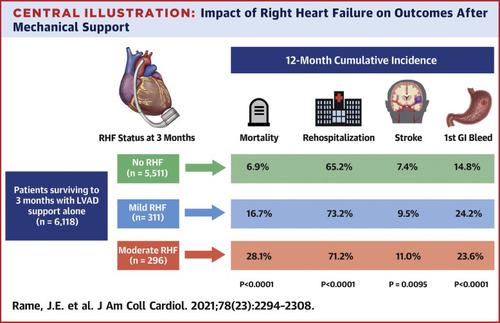Journal of the American College of Cardiology ( IF 24.0 ) Pub Date : 2021-11-29 , DOI: 10.1016/j.jacc.2021.09.1362 J Eduardo Rame 1 , Francis D Pagani 2 , Michael S Kiernan 3 , Guilherme H Oliveira 4 , Edo Y Birati 5 , Pavan Atluri 6 , Ann Gaffey 6 , E Wilson Grandin 7 , Susan L Myers 8 , Craig Collum 8 , Robert L Kormos 9 , James K Kirklin 8 , Jeffrey J Teuteberg 10

|
Background
A revised definition of right heart failure (RHF) for the Society of Thoracic Surgeons Intermacs database of left ventricular assist devices (LVADs) was introduced in June 2014.
Objectives
The purpose of this study was to determine the prevalence and severity of RHF over time and the association of RHF status at 3 months with 12-month outcomes after LVAD.
Methods
All patients in Society of Thoracic Surgeons Intermacs with follow-up and supported at least 3 months with a continuous flow LVAD implanted between June 2, 2014 and March 31, 2017 without a simultaneous RVAD. RHF was defined as both documentation and manifestations of elevated central venous pressures.
Results
There were 6,118 patients included with an incidence of RHF at 3, 6, and 12 months postimplant categorized as mild in 5%, 6%, and 6% and moderate in 5%, 3%, and 3%, respectively. For those with no RHF at 3 months, there was a low incidence of subsequent RHF at 6 and 12 months. The lack of RHF at 3 months, compared with mild and moderate RHF, was associated with a lower 12-month cumulative incidence of mortality (6.9% vs 16.7% vs 28.1%; P < 0.0001) and a lower 12-month cumulative incidence of stroke (7.4% vs 9.5% vs 11.0%; P = 0.0095), gastrointestinal bleeding (14.8% vs 24.2% vs 23.6%; P < 0.0001), and rehospitalization (65.2% vs 73.2% vs 71.2%; P < 0.0001).
Conclusions
In patients surviving 3 months with LVAD support alone, mild or moderate RHF occurred in nearly 1 of 10 patients at 12 months. Patients with late RHF had worse survival and a higher cumulative incidence of major adverse events.
中文翻译:

左心室辅助装置晚期右心衰竭的演变及其与结果的关联
背景
2014 年 6 月,胸外科医师协会 Intermacs 左心室辅助装置 (LVAD) 数据库修订了右心衰竭 (RHF) 定义。
目标
本研究的目的是确定 RHF 随时间推移的患病率和严重程度,以及 3 个月时的 RHF 状态与 LVAD 后 12 个月结果的关联。
方法
2014 年 6 月 2 日至 2017 年 3 月 31 日期间,胸外科医师协会 Intermacs 的所有患者均接受了随访并支持至少 3 个月的连续流 LVAD 植入,但没有同时使用 RVAD。RHF 被定义为中心静脉压升高的记录和表现。
结果
共有 6,118 名患者在植入后 3、6 和 12 个月时发生 RHF,分别被归类为轻度的 5%、6% 和 6% 和中度的 5%、3% 和 3%。对于 3 个月时未出现 RHF 的患者,在 6 个月和 12 个月后发生 RHF 的发生率较低。与轻度和中度 RHF 相比,3 个月时缺乏 RHF 与较低的 12 个月累积死亡率相关(6.9% vs 16.7% vs 28.1%;P < 0.0001)和较低的 12 个月累积死亡率卒中(7.4% vs 9.5% vs 11.0%;P = 0.0095)、胃肠道出血(14.8% vs 24.2% vs 23.6%;P < 0.0001)和再住院(65.2% vs 73.2% vs 71.2%;P < 1)。
结论
在仅靠 LVAD 支持存活 3 个月的患者中,12 个月时 10 名患者中有近 1 名发生轻度或中度 RHF。晚期 RHF 患者的生存期较差,主要不良事件的累积发生率较高。



























 京公网安备 11010802027423号
京公网安备 11010802027423号